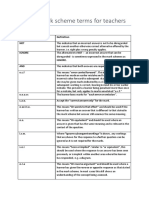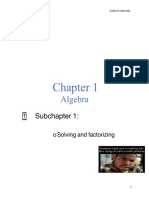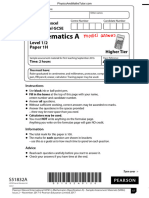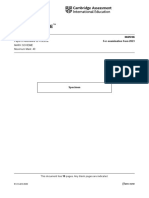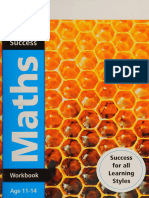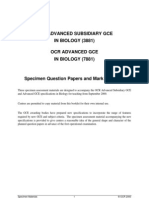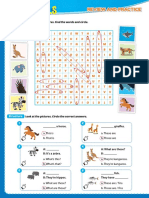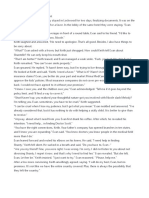ZNOTES.
ORG
UPDATED TO 2019-21 SYLLABUS
CAIE AS LEVEL
BIOLOGY (9700)
SUMMARIZED NOTES ON THE PRACTICAL SYLLABUS
�CAIE AS LEVEL BIOLOGY (9700)
Convert the measurement from millimeter to
micrometer
1. Manipulation of Apparatus, Apply the magnification equation
Calculating the real size of an object from its
Measurements & magnification
Measure the observed length of the image in mm
Mathematics using a ruler
Convert the measurement from millimeter to
micrometer
1.1. Eyepiece Graticule & Stage
Apply the equation to calculate the actual length,
Micrometer using given value of the magnification.
When counting in grids, count half squares and full
Eyepiece graticule is a transparent scale with 100 square as one square. The final answer should be a
divisions, which is placed in the microscope eyepiece. whole number or 0.5.
Stage micrometer is a transparent ruler which is used to Smaller grid size increases accuracy of measurements.
calibrate the eyepiece graticule. The calibrated eyepiece graticule can be used to measure
Each division on the stage micrometer is 0.01mm. the diameter of a certain area of field view. It can then be
The eyepiece graticule can be calibrated using the used to find area of field view.
following steps: It can be used to measure lengths of cells in certain areas.
Place a micrometer slide on the stage of the Take at least 5 measurements to increase accuracy of
microscope results.
Focus on the micrometer scale using the low-power % error = No. of readings ×Total
Half of smallest scale division
×
reading
objective lens.
100%
Move the slide and rotate the eyepiece to align the
scales of the eyepiece graticule and the micrometer
Mean = Sum of data
No. of data
Useful for replicated readings.
scale in the field of view Δy
Count the number of divisions on the eyepiece Gradient = Δx , where Δy & Δx are height and width
graticule and compare them to a known length on the of triangle.
micrometer scale to figure out the length of one Draw right-angled triangle from 2 points on straight line
eyepiece unit graph or tangent of curve; Ensure that triangle exceeds
Repeat steps 1-3 with the medium-power and high- half of graph.
Final – Initial
power objective lens. % change = Initial
× 100%
It makes comparing easier by negating effects of
differences in initial readings between samples.
Error in a measurement is half of the value of
the smallest division on the scale you are reading from.
If you read from two positions in the scale, i.e., initial, and
final reading, the error is multiplied by 2 because error in
measurements can occur twice
To calculate percentage uncertainty, use the equation:
uncertainty
percentage of uncertainty = × 100
actual measurement
1.3. Variables
1.2. Magnification & Mathematics
Independent Variable is the factor whose values are
Magnification, M = Image size, I / Actual size, A
decided (and can be changed) by the experimenter. It is
Calculating the magnification of a photomicrograph or an plotted on the x-axis of the graph. (Bold in examples)
image Dependent Variable is the factor whose results need to
Measure the width of the cell in mm on the be collected during/after the experiment. These results
photomicrograph using a ruler are out of control. It is plotted on the y-axis of the graph.
Convert the measurement from millimeter to (Italics in examples)
micrometer.
Enzyme concentration on the rate of activity of rennin
Apply magnification equation, using given value of the Temperature effects on the rate of activity of catalase
actual size.
Surface area effects on the rate of diffusion
Calculating magnification from a scale bar
Measure the given scale bar using ruler
WWW.ZNOTES.ORG
�CAIE AS LEVEL BIOLOGY (9700)
Concentration of a solution effects on the percentage of Systematic errors occur throughout the experiments, as
onion cells that become plasmolysed. they result from uncertainties in measurements.
Random errors differ across experiments as they arise
Standardized Variable is the factor that can affect the rate due difficulties in controlling standardized variables and
of reaction, reducing the reliability of the experiment. It is measurements of dependent variable.
also known as control. Anomalous readings are too low/too high/does not fit the
Quantitative tests require numerical measurements to be trend and are usually discarded, and the experiment
taken. repeated.
Qualitative tests require the quantification of
observation, i.e. the presence or absence of starch in a
sample after performing the starch iodide test.
1.5. Modifications & Improvements of
Semi-quantitative tests are used to confirm the presence experiments
of certain chemicals in a sample, and their approximate
concentration. In Benedict’s test, red colour shows To standardize temperature, use thermostatically
presence of sugar in high concentrations, whereas yellow controlled water bath
colour shows presence of sugar in low concentrations Use colorimeter instead of colour chart to compare
colours.
1.4. Common Errors in Experiments Use buffer solutions to standardize pH, datalogger and
pH sensor to measure pH.
Difficult to judge/compare colour/colour change using Use same size/shape/volume/mass/surface area of the
colour charts. prime sample of investigation (e.g. potato strips/leaves)
In experiments that use water-baths, temperature of the from the same plant/potato when experimenting for
test tube falls when it is removed from the water bath. effects of other independent variables on the
Fast changes in colour/formation of bubbles can cause strips/leaves.
errors in timing, i.e., stopwatch started/stopped Use larger numbers of the prime sample of investigation
late/early. (e.g. potato strips/leaves)
Difficult to start/stop stopwatch and add/remove samples Use digital balance to measure mass accurately.
at the same time. To keep surface area constant, use Vernier calipers to
Difficult to judge and count the number of cells that are measure lengths and sharp scalpel to cut (e.g. potato
plasmolysed. strips).
In experiments where length/width/diameter of specimen Use graduated pipettes to measure small volumes of
is measured, error occurs due to difficulty in focusing solution accurately.
both ruler and specimen at the same time; parallax error; In Benedict’s tests, heat samples for the same amount of
thickness of ruler lines. time.
In immobilizing enzyme reactions, error can occur due to Carry out experiments for the same amount of time if
sodium alginate beads: time is not the independent variable. To do this, stagger
sticking to the sides of the tube start or carry out experiments separately.
sticking together with those already dropped Carry out experiments at wider ranges of
floating up under each other temperature/concentrations (at least 5)
In experiments that require shaking of test tubes, errors Make wider ranges of concentration using serial or simple
can occur due to uneven shaking/varying forces used to dilutions.
shake the tubes. Repeat experiments at each temperature/concentration
Errors can occur due to different sizes of bubbles, 3-5 times AND take the mean of results.
difficulty in counting number of bubbles (fast formation). Keep volumes of solution same throughout all the
In experiments that require formation of drops using repeats (using graduated pipette/burette).
syringe, error due to different sizes of drops as pressure During Benedict’s tests, keep temperature at around 80-
applied on the syringe. 100 degrees Celsius.
In experiments that require measurements to be made Use same volume of Benedict’s solution in all tests.
using eyepiece graticule and stage micrometer, errors Cover H2O2 with lid/aluminum foil to prevent
can occur due to degeneration.
Difficulty in judging the edge of the specimen Dry test tube with white towel or use new test tubes
irregular shape of specimen. before starting each experiment
Errors can occur due to decrease in Hydrogen peroxide To prevent evaporation, use rubber bungs in test tubes
concentration if left open, as H2O2 degenerates. or cover the containers (air-tight).
Errors can occur if test tubes used are not dry, as To standardize the position of delivery of solution into a
droplets on water on sides of test tube can reduce test tube, make a mark on the test tube.
experiment’s reliability. Use magnetic stirrer to prevent errors caused by uneven
shaking of test tubes.
WWW.ZNOTES.ORG
�CAIE AS LEVEL BIOLOGY (9700)
increase evaporation rates in experiments 2. Photomicrographs of
Increase temperatures using thermostatically
controlled water bath. Specimen & Biological
Increase wind speed using fan (keep fan speed
constant). Drawings
Decrease humidity using fan or
(calcium/sodium/potassium) 2.1. Common Photomicrographs
hydroxide/chloride/oxide
Silica gel/drying agent
Mitosis
dehumidifier
In experiments where oxygen is released, gas syringe can
be used to collect oxygen; oxygen sensor can be used to
detect oxygen produced.
Burettes can be used to make drop sizes similar since
pressure is not applied as in syringes.
To control the effects of light intensity, the lamp can be
set at a constant distant/power.
Place a container of water in front of the lamp to act as a Early Anaphase
heat shield.
Alter light intensity by increasing power or adding more
identical lamps.
Other standardized variables include mass,
concentration, volume, source, age, storage, conditions,
and genotype of sample depending on the requirements
of the experiment.
Late Anaphase
1.6. Quality of Measurements
Term Explanation Improvement
Accuracy Closeness to true value Better instruments
Closeness to repeated
Precision Control all variables
readings
Repeat readings and
Reliability Confidence in results
take mean Transverse Section of Root
Agreement between Check relation between
Validity hypothesis and key and derived
investigation variables
1.7. Methods of dilution & Slide
Preparation
Two common types of dilution are: Transverse section of Stem
Simple, where a stock solution is diluted by different
ratios:
STOCK solution Final solution
Volume of
Conc. / Conc. /
Volume H2O added Volume /
mol dm − mol dm −
− 3 − 3
/ cm / cm cm − 3
3 3
1.0 80 2.0 0.8 10.0
1.0 6.0 4.0 0.6 10.0
1.0 4.0 6.0 0.4 10.0
Stem Collenchyma
1.0 2.0 8.0 0.2 10.0
WWW.ZNOTES.ORG
�CAIE AS LEVEL BIOLOGY (9700)
Transverse section of Guard Cells
Sclerenchyma
Transverse section of Mesophytic Dicot Leaves
Pith of Stem
Transverse section of Dicot Leaves Transverse section of Xerophytic Leaves
Transverse section of Stomata
Transverse section of Lamina
Longitudinal section of Stem
WWW.ZNOTES.ORG
�CAIE AS LEVEL BIOLOGY (9700)
Longitudinal section of Root’
WWW.ZNOTES.ORG
�CAIE AS LEVEL BIOLOGY (9700)
Transverse section of Trachea
Transverse section of Bronchus
Sieve Tubes
Transverse section of Bronchiole
Transverse section of Lung, Lung tissue and Alveoli
WWW.ZNOTES.ORG
�CAIE AS LEVEL BIOLOGY (9700)
Plant Cell
Protoctists (Amoeba)
2.2. Biological Drawings
Draw in clear, unbroken lines. Do not sketch.
Label using straight and horizontal lines.
Transverse section of Artery Low power diagrams
Identify the different tissues, using high power to help
if necessary.
Draw all tissues and completely enclose each tissue
by lines.
Do not draw individual cells.
Accuracy is important. Do not draw from imagination.
Draw only what you see.
High power diagrams
Transverse section of Vein Make large drawings of cells.
Draw the nuclei but do not shade it
3. Presentation of Data &
Observations
3.1. Tabulating Results
Blood Smear
Draw table with neat, ruled pencil lines.
Give each column suitable heading (Quantity/SI unit)
Arrange columns in order: independent, dependent &
derived variable.
Round data to same number of decimal places to
maintain consistency.
Animal Cell 3.2. Plotting Graphs
Decide type of graph:
Line graph (Both variables are continuous)
WWW.ZNOTES.ORG
�CAIE AS LEVEL BIOLOGY (9700)
Histogram (Independent variable is continuous) Do not extrapolate the line.
Bar chart (Dependent variable is continuous)
Bars touch in histograms only, not in bar charts. 3.3. Describing & Interpreting Data
Independent variable at x-axis and dependent at y-axis.
Describe overall trend.
Use linear scale with sensible (1s, 2s, 5s, 10s, …) intervals.
Comment on changes in gradient.
Axes do not have to stand out. If they do, a break should
Quote figures with units to support claim.
be indicated.
Avoid phrases that suggest something is happening over
Use more than half of the graph paper provided.
time unless it is the independent variable.
Label each axis fully, according to variable’s column
Draw a conclusion by connecting it to description using
heading.
theoretical reasoning.
For line graphs: Conclusion should be simple, clean, focused and
Plot points with ✕ or ⊙ marks. scientifically explainable statement describing deduction
Join successive points with straight lines. regarding the hypothesis from results.
If there is a clear relation, draw smooth wave, or line
of best fit.
WWW.ZNOTES.ORG
�CAIE AS LEVEL
Biology (9700)
Copyright 2022 by ZNotes
These notes have been created by Faisal Bin Ibrahim for the 2019-21 syllabus
This website and its content is copyright of ZNotes Foundation - © ZNotes Foundation 2022. All rights reserved.
The document contains images and excerpts of text from educational resources available on the internet and
printed books. If you are the owner of such media, test or visual, utilized in this document and do not accept its
usage then we urge you to contact us and we would immediately replace said media.
No part of this document may be copied or re-uploaded to another website without the express, written
permission of the copyright owner. Under no conditions may this document be distributed under the name of
false author(s) or sold for financial gain; the document is solely meant for educational purposes and it is to remain
a property available to all at no cost. It is current freely available from the website www.znotes.org
This work is licensed under a Creative Commons Attribution-NonCommerical-ShareAlike 4.0 International License.







